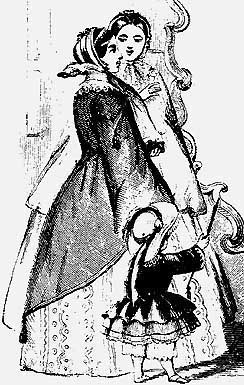 CHARLESTON
MERCURY, September 21, 1861, p. 1, c. 3
Flint Hill, Fairfax Co., Va., September 14.
"The excitement of camp life!" What a myth!
Catch your youngbirds with chaff, but don't try to
sprinkle this sort of husk on the tail of an old one. If
you _really_ want excitement, go to a Quaker Meeting,
attend a lecture on Phrenology, illustrated by the
examination of decrepit old gentlemen's head, spend some
Sunday afternoon in the Fish Market--these are lively and
diverting amusements compared to the company, battalion,
and brigade drills--the breakfast, dinner and supper
cooking--the noonday doze, the afternoon nap, the long
uneasy night slumber--the dirt, the smoke, the heat, the
rain--which make up the sum of a camp day's unrelieved
and intolerable tedium.
CITRON PUDDING
Take half pint of cream, one
tablespoon full of flour, two ounces of white sugar, and
little grated nutmeg. Mix all these ingredients together
with the well-beaten yolks of three eggs. Cut two ounces
of citron into thin slices, place pieces of it in small
buttered moulds or cups, fill them with the mixture, and
bake until the pudding assumes a light brown color. This
quantity will make five puddings.
Peterson's Magazine. March,
1863.]
|
Flowers of
the South Living History Society
back to
FSLHS home
The Home Companion
Suggested method for
making worked button holes...
A thread button hole is also
called a worked button hole. When done correctly, the
worked button hole can outlast a machine button hole.
1. Mark each button hole
with a pencil.
2. Using #40 or #50
mercerized cotton thread, baste around each button
hole, before you cut.
3. After you have marked the
button hole, basted around the place to be cut, and
made the cut, your next step is to overcast the cut
edges so they will not ravel. Overcasting also
provides "body" for your button hole
stitch.
4. The needle is inserted
under the edge of the button hole to whatever depth
seemed desirable and the thread brought under the
point of the needle as shown below.
5. Button hole stitches are
taken close together, so that you cannot see the
fabric showing between the stitches, but they do not
overlap. The depth, or bit, of the stitches is
determined by the size of the button hole, and the
type of fabric used. Naturally, a large button hole
on a heavy fabric will have stitches which go deeper
into the material than those in a tiny button hole on
a lightweight fabric.
6. The end of the button
hole which bears the greater strain should be
finished with a group of stitches worked fanshape.
(This is the end which has the pulling against it.)
Make a bar tack, as shown, at the opposite end.


From Peterson's Magazine, February, 1862.
|


